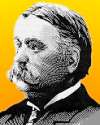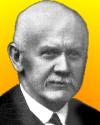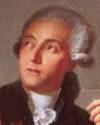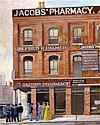 | TODAY IN SCIENCE HISTORY NEWSLETTER - 8 MAY |
| Feature for Today |
 On 8 May 1855, John W. Gates was born. He started with a small manufacturing business, which he energetically promoted. He was an astute speculator, a hustler, and with his bravado eventually became a steel baron. On 8 May 1855, John W. Gates was born. He started with a small manufacturing business, which he energetically promoted. He was an astute speculator, a hustler, and with his bravado eventually became a steel baron.A biography of John W. Gates, from Munsey's magazine (1906), provides some background for this interesting character. |
| Book of the Day | |
| |
| Quotations for Today | |
 | "The mechanist is intimately convinced that a precise knowledge of the chemical constitution, structure, and properties of the various organelles of a cell will solve biological problems. This will come in a few centuries. For the time being, the biologist has to face such concepts as orienting forces or morphogenetic fields. Owing to the scarcity of chemical data and to the complexity of life, and despite the progresses of biochemistry, the biologist is still threatened with vertigo." |
 | "There was once an Editor of the Chemical Society, given to dogmatic expressions of opinion, who once duly said firmly that 'isomer' was wrong usage and 'isomeride' was correct, because the ending 'er' always meant a 'do-er'. 'As in water?' snapped Sidgwick." |
 | "Chemists have made of phlogiston a vague principle which is not at all rigorously defined, and which, in consequence, adapts itself to all explanations in which it is wished it shall enter; sometimes it is free fire, sometimes it is fire combined with the earthy element; sometimes it passes through the pores of vessels, sometimes they are impenetrable to it; it explains both the causticity and non-causticity, transparency and opacity, colours and absence of colours. It is a veritable Proteus which changes its form every instant. It is time to conduct chemistry to a more rigorous mode of reasoning ... to distinguish fact and observation from what is systematic and hypothetical." |
| QUIZ | |
| Before you look at today's web page, see if you can answer some of these questions about the events that happened on this day. Some of the names are very familiar. Others will likely stump you. Tickle your curiosity with these questions, then check your answers on today's web page. | |
| Births | |
 |  John Warne Gates, born 8 May 1855, was nicknamed John "Bet A Million" Gates. He was a salesman who changed the nature of the Western Plains ranches with a new way to control and protect their livestock. John Warne Gates, born 8 May 1855, was nicknamed John "Bet A Million" Gates. He was a salesman who changed the nature of the Western Plains ranches with a new way to control and protect their livestock. What invention did he promote? What invention did he promote? |
 |  Emil Christian Hansen, born 8 May 1842, was a Danish botanist who worked for the Carlsberg breweries. From his laboratory studies, he improved beer-making and allowed his discovery to be used by brewers throughout Europe and the world. Emil Christian Hansen, born 8 May 1842, was a Danish botanist who worked for the Carlsberg breweries. From his laboratory studies, he improved beer-making and allowed his discovery to be used by brewers throughout Europe and the world. What did he develop? What did he develop? |
| Deaths | |
 |  This English photographer (1830-1904) was important for his pioneering work in photographic studies of motion and in motion-picture projection. For his work on human and animal motion, he invented a superfast shutter. He showed, for example, whether a galloping horse ever had all four feet off the ground, or not. This English photographer (1830-1904) was important for his pioneering work in photographic studies of motion and in motion-picture projection. For his work on human and animal motion, he invented a superfast shutter. He showed, for example, whether a galloping horse ever had all four feet off the ground, or not. Can you name him? Can you name him? |
 |  This French scientist (1743-1794) died on the guillotine during the French Revolution. Yet, for his brilliant experimental work before he died, he is known the "father of modern chemistry." In 1778, he found that air consists of a mixture of two gases which he called oxygen and nitrogen. He studied the role of oxygen in combustion, and replaced the phlogiston theory. This French scientist (1743-1794) died on the guillotine during the French Revolution. Yet, for his brilliant experimental work before he died, he is known the "father of modern chemistry." In 1778, he found that air consists of a mixture of two gases which he called oxygen and nitrogen. He studied the role of oxygen in combustion, and replaced the phlogiston theory. Can you name him? Can you name him? |
| Events | |
 In 1992, the source of the "red tide" in the Gulf of Mexico was suggested by scientists at a conference on the ecology of the Gulf. In 1992, the source of the "red tide" in the Gulf of Mexico was suggested by scientists at a conference on the ecology of the Gulf. What caused the reddish colour of the Gulf waters? What caused the reddish colour of the Gulf waters? | |
 |  In 1886, this soft drink was sold for the first time at the soda fountain of Jacob's Pharmacy in Atlanta, Georgia. Pharmacist John Pemberton mixed it in a 30-gallon brass kettle hung over a backyard fire. At the time it was marketed as a "brain and nerve tonic." In 1886, this soft drink was sold for the first time at the soda fountain of Jacob's Pharmacy in Atlanta, Georgia. Pharmacist John Pemberton mixed it in a 30-gallon brass kettle hung over a backyard fire. At the time it was marketed as a "brain and nerve tonic."  What is the name of this drink? What is the name of this drink? |
 In 1790, the French National Assembly took the first step towards establishing the metric system. They decided to create reliable units of measurement that would be stable and simple. At this meeting they agreed on the definition of the first unit, and charged scientists of the French Academy of Sciences to develop more. In 1790, the French National Assembly took the first step towards establishing the metric system. They decided to create reliable units of measurement that would be stable and simple. At this meeting they agreed on the definition of the first unit, and charged scientists of the French Academy of Sciences to develop more. What was this first unit? What was this first unit? | |
| Answers |
When you have your answers ready to all the questions above, you'll find all the information to check them, and more, on the May 8 web page of Today in Science History. Or, try this link first for just the brief answers. Fast answers for the previous newsletter for May 7: ribonucleic acid; Edwin Herbert Land; computerized axial tomography (CAT); steam hammer; Telstar II; polio; integrated circuit chip. |
| Feedback |
 If you enjoy this newsletter, the website, or wish to offer encouragement or ideas, please send feedback by using your mail reader Reply button. If you enjoy this newsletter, the website, or wish to offer encouragement or ideas, please send feedback by using your mail reader Reply button. |
--
If you do not want to receive any more newsletters, this link
To update your preferences and to unsubscribe visit this link
If you do not want to receive any more newsletters, this link
To update your preferences and to unsubscribe visit this link
! !



Δεν υπάρχουν σχόλια:
Δημοσίευση σχολίου